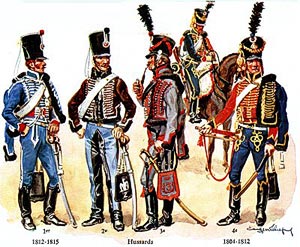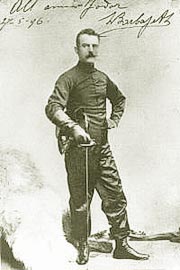|
|
The SABRE
-
The Hussars
Weapon
A short history
of the Sabre |
|
 |
En garde in Sabre with cover in tierce.
As sabre is fenced with absence of blade, the point is held high,
affording maximum cover to the flank and cheek on the tierce
line.
 The
first mention of the sabre in print comes in Marcelli's manual
(1686). Originally the heavy, curved, weapon with which the
Household Cavalry is still equipped today, it became known in
western Europe during the eighteenth century as a result of the
contact with the Hungarian light horsemen (hussars) who had
originally derived the weapon from the oriental scimitar of the
Ottoman Turk. The
first mention of the sabre in print comes in Marcelli's manual
(1686). Originally the heavy, curved, weapon with which the
Household Cavalry is still equipped today, it became known in
western Europe during the eighteenth century as a result of the
contact with the Hungarian light horsemen (hussars) who had
originally derived the weapon from the oriental scimitar of the
Ottoman Turk.
In the eighteenth and nineteenth centuries cavalrymen of all
nations practiced sabre fencing. The French cavalry commander
General Chablis commented:
"The sabre is the
cavalryman's science of survival"

Hussars
Much of modern sabre
play is derived from its cavalry application, for example the
target area, everything above an imaginary line across the hips
known as the saddle line, as any attacks below this would hit
horse. One unique feature of modern sabre fencing is that an
off-target hit, will not stop the action as it would in foil
fencing.
In the eighteenth century the court-sword was regarded as
essentially the gentleman's sword and from association the foil
received the same prestige in the fencing salle. The sabre was
originally considered to be a rather crude affair for the
military. The Napoleonic wars aroused a passing enthusiasm for
edged weapons, primarily due to army and naval officers having
to be trained in its use for practical application in battle.

George Roland poured scorn on the sabre, and most traditionally
minded foilists affected to regard it with disdain. Only at the
nineteenth century's end did such great Italian masters such as
Radaelli and Magrini confer respectability on their chosen
weapon, since then it has gained steadily in popularity, even
though the Italian style has given way entirely to Hungarian
influence.

The present day weapon is extremely light and flexible. The
sabre is unique as it is the only weapon which the edge is also
counted as an offensive area, ie the sabre truly is the 'cut and
thrust' of fencing weapons. Hits can be scored with the entire
length of the cutting edge (the fore-edge) and the top third of
the back edge as well, both coming to a point which is also used.
The contemporary blade is entirely straight. Until recently
there were many variations of sabre design in fencing, with
curved blades not being uncommon as long as the vestigial curve
did not deviate more than 40mm from the straight line. The
curved, triangular guard, reminiscent of the old basket-hilted
swords, must now be absolutely smooth; whereas just as blades
differed, guards (or coquilles) were often perforated, grooved,
patterned or embossed.

Typology of the blades
The technique in making a hit at sabre, ie the characteristic
sabre cut has been the subject of controversy and has undergone
sundry vicissitudes over the years. The military pushed the
forearm slash, delivered from the elbow, or even the shoulder.
However the Hungarian masters revolutionised sabre-play. The
great Keresztessy of Budapest, preferred the use of the wrist,
the first step toward modern technique. In
|
 |
|
Luigi Barbasetti -1896 |
the mid nineteenth
century the Italian master Barbasetti took charge of the
Austrian army, and he insisted in a return to the forearm method.
The school of technique advocating action from the elbow became
know as the Italian method, and in many ways Barbasetti's action
can be viewed as a retrograde step in the development of sabre
fencing. Ironically it was left to Santelli, an Italian
expatriate to introduce to Hungary the classic wrist and finger
action which has become universally adapted as sabre technique
and has facilitated the speed and rapid inter-exchange of attack
and defence characteristic of modern sabre fencing, known as the
Hungarian method. Modern sabre fencing has rules and conventions
similar to that of foil they were framed in Paris in 1914 by a
committee under the chairmanship of Dr Bela Nagy, president of
the Hungarian Fencing Federation, and since have only been
modified in detail.

Modern Electric
Saber
Sources:
www.uucfencing.co.uk/history/history-of-sabre, arms-museum.tulanews.ru,
www.tcasfencing.com, www.geocities.com,
Gerakla-ula-masters.com.ru, www.gelos.ru
|

 The
first mention of the sabre in print comes in Marcelli's manual
(1686). Originally the heavy, curved, weapon with which the
Household Cavalry is still equipped today, it became known in
western Europe during the eighteenth century as a result of the
contact with the Hungarian light horsemen (hussars) who had
originally derived the weapon from the oriental scimitar of the
Ottoman Turk.
The
first mention of the sabre in print comes in Marcelli's manual
(1686). Originally the heavy, curved, weapon with which the
Household Cavalry is still equipped today, it became known in
western Europe during the eighteenth century as a result of the
contact with the Hungarian light horsemen (hussars) who had
originally derived the weapon from the oriental scimitar of the
Ottoman Turk.




